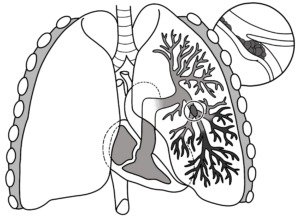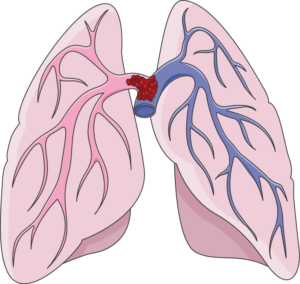
That’s one of the most frightening symptoms: a sudden feeling of being short of breath even though you’re at rest.
Even if the sensation of being short of oxygen is your only symptom — it’s still scary and should not be ignored.
A sudden feeling of being out of breath or that of not getting enough air isn’t always caused by a heart problem.
You May Have a Pulmonary Embolism
“One of the most common presenting complaints associated with pulmonary embolism is shortness of breath,” says Christopher J. Hanifin, PA-C, who was previously a physician assistant in open heart surgery with Cardiothoracic Surgery of South Bend in South Bend, IN.
“In a pulmonary embolism, a clot breaks loose from somewhere in the body – typically a leg vein – and lodges in an artery in one or both lungs.

Pulmonary embolism
“The affected areas in the lung lose the ability to transfer oxygen into the bloodstream.
“If a large enough area is affected, the body senses a drop in oxygen, leading to a sensation of shortness of breath.
“Different conditions lead to different types of shortness of breath.
“Many conditions that cause shortness of breath – like asthma – cause the sensation that a patient cannot move enough air in and out.
“A person with a pulmonary embolism does not have trouble moving air in and out, but they still feel like they are not getting enough air.”
To have an idea of what this could feel like, walk on a treadmill at two mph and five percent incline – assuming that your body is not used to incline walking.
- Do NOT hold onto the machine, not anywhere. Hands are free.
- Breathe only through your nose; do not open your mouth to take in air – not even a sliver.
- Keep the mouth sealed.
- You will not have difficulty moving air in and out – no issue with the mechanics. But you will feel shorted of air.
Shortness of Breath May Be the Only Symptom
Research from Saint Vincent’s Medical Center in Bridgeport, Connecticut, revealed in 2012 that out of 334 patients with a confirmed pulmonary embolism, 29 percent had difficulty breathing without any other symptoms.
Three Key Symptoms of a Pulmonary Embolism
- A sensation of difficulty breathing or of being short of breath
- Chest pain
- Cough
This sounds like a heart attack, but you can have a perfectly normal heart while experiencing a pulmonary embolism – which can kill in minutes without emergency medical attention.
Any combination of these symptoms can occur from a pulmonary embolism — including one of them in isolation.
The biggest risk factor for a P.E. is a deep vein thrombosis.

A “saddle” type pulmonary embolism, plugging up the area where the pulmonary artery splits off into each lung. This can cause death in minutes. Laboratoires Servier, CC BY-SA/creativecommons.org/Wikimedia Commons
Risk Factors for a DVT
- Extended air travel or hours driving without a break
- Smoking
- Obesity
- Lack of exercise
- Use of birth control pills
- Pregnancy
- Recent joint replacement or abdominal surgery
- Excessive bed rest
- Old age
- Family history of DVT
- Heart disease
If you suddenly “can’t breathe” or have difficulty breathing, it’s important to know what your very recent history of activities has been, such as having recently gotten off a plane after a long flight or being on birth control while maintaining a smoking habit.
This information will help in the ER, though the symptom complaint of “trouble breathing” or “shortness of breath” will always net a blood test to check for the presence of a blood clot.
 Christopher J. Hanifin, PA-C, is currently Department Chair and Assistant Professor, Department of Physician Assistant, Seton Hall University, NJ.
Christopher J. Hanifin, PA-C, is currently Department Chair and Assistant Professor, Department of Physician Assistant, Seton Hall University, NJ.
 Lorra Garrick has been covering medical, fitness and cybersecurity topics for many years, having written thousands of articles for print magazines and websites, including as a ghostwriter. She’s also a former ACE-certified personal trainer.
Lorra Garrick has been covering medical, fitness and cybersecurity topics for many years, having written thousands of articles for print magazines and websites, including as a ghostwriter. She’s also a former ACE-certified personal trainer.
.












